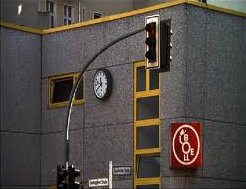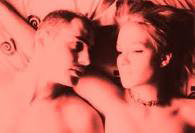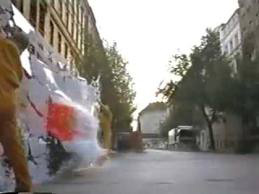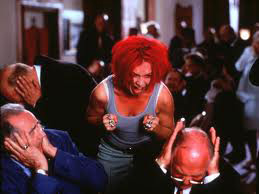FILM THEORY & CRITICISM
Lola's Game of Life
I remember the first time I saw Run Lola Run (Tom Tykwer, 1998), it was showing on a paid cable channel that I scrolled past and then back again to see "what in the world was that?" I sat through the exhilarating ride and didn't find out what the film was called until days later. The next time I watched it, years later, was for my Intro to Film course here at UCD and with that screening I found an unexpected passion coursing through my being for it. I like to see the film as a game, with 3 rounds, and there is no possible way to discuss every interesting layer in one paper. The pacing is fast and every moment is filled with delectably detailed mise-en-scene; it takes a number of screenings to realize that some deeper message is begging to be noticed. That's what I love: when films bring forth a message or a metaphysical insight about our human existence!
 For my purposes here, I have placed my magnifying glass upon the visual motifs in Run Lola Run; the repeated circles, clocks and spirals are among the most interesting to consider. What is the connection between them? What does Tykwer want us, his viewers, to derive from seeing all these symbols as motifs in his film? They all represent some aspect of nature and the cycle of life. The exterior façade of the film is a fast-paced race against the clock, in which Lola (Franka Potente) endeavors to come up with 100,000 marks in the next 20 minutes or else her boyfriend Manni (Moritz Bleibtreu) will die. However, behind the mask of intense action and suspense, Run Lola Run takes us on a metaphysical journey through three rounds of a "game." I call it Lola's "game of life."
For my purposes here, I have placed my magnifying glass upon the visual motifs in Run Lola Run; the repeated circles, clocks and spirals are among the most interesting to consider. What is the connection between them? What does Tykwer want us, his viewers, to derive from seeing all these symbols as motifs in his film? They all represent some aspect of nature and the cycle of life. The exterior façade of the film is a fast-paced race against the clock, in which Lola (Franka Potente) endeavors to come up with 100,000 marks in the next 20 minutes or else her boyfriend Manni (Moritz Bleibtreu) will die. However, behind the mask of intense action and suspense, Run Lola Run takes us on a metaphysical journey through three rounds of a "game." I call it Lola's "game of life."
 Ralph Waldo Emerson said, "Our life is an apprenticeship to the truth that around every circle another can be drawn; that there is no end in nature, but every end is a beginning, and under every deep a lower deep opens." Throughout the rounds, we see many circles in the film; so many, in fact, that we have to wonder about a deeper meaning behind this mise-en-scène choice. Circles are everywhere: every clock, numerous street signs, arches and tunnels that Lola runs through repeatedly. On the security guard's hat at the bank, we see a circle symbol. On the corner where Manni waits in the phone booth, we repeatedly see the circle of the Bolle logo and the spinning spiral at the Spirale Bar. We see the round Mercedes symbol on the front of the ambulance and the circular jewelry that Lola wears on her fingers.
Ralph Waldo Emerson said, "Our life is an apprenticeship to the truth that around every circle another can be drawn; that there is no end in nature, but every end is a beginning, and under every deep a lower deep opens." Throughout the rounds, we see many circles in the film; so many, in fact, that we have to wonder about a deeper meaning behind this mise-en-scène choice. Circles are everywhere: every clock, numerous street signs, arches and tunnels that Lola runs through repeatedly. On the security guard's hat at the bank, we see a circle symbol. On the corner where Manni waits in the phone booth, we repeatedly see the circle of the Bolle logo and the spinning spiral at the Spirale Bar. We see the round Mercedes symbol on the front of the ambulance and the circular jewelry that Lola wears on her fingers.
 The circle represents the never-ending cycle of life. It has no end and no beginning. It is a symbol for the continuity of life. Like Run Lola Run, the circle brings us back to the beginning again and again, analogous to the concept of reincarnation. With each round, Lola either dies or fails in her task and then is reborn into a new round of the game. Tykwer uses beautiful transition scenes between rounds where Lola and Manni engage in "pillow talk" about the philosophical topics of love, life and death. A dialogue hook at the end of each transition scene brings us back to the game for Lola to start again. A clever moving match cut turns a bag of money into the red phone receiver in her apartment, and Lola is off and running—reborn into the next round.
The circle represents the never-ending cycle of life. It has no end and no beginning. It is a symbol for the continuity of life. Like Run Lola Run, the circle brings us back to the beginning again and again, analogous to the concept of reincarnation. With each round, Lola either dies or fails in her task and then is reborn into a new round of the game. Tykwer uses beautiful transition scenes between rounds where Lola and Manni engage in "pillow talk" about the philosophical topics of love, life and death. A dialogue hook at the end of each transition scene brings us back to the game for Lola to start again. A clever moving match cut turns a bag of money into the red phone receiver in her apartment, and Lola is off and running—reborn into the next round.

"In ancient Britain, the spiral [has] been associated with the feminine as the doorway to life. It has been associated with the cycles of time, the seasons, and the cycle of birth, growth, death, and then rebirth. The cycles of time and nature are the cycles of life." In nature, the spiral shows up everywhere—in the shape of the nautilus shell, the shape of hurricanes and tornadoes, in the helix of the DNA molecule, and it is the shape of our very own galaxy! All of these things occur naturally in the universe and represent time, growth, and the cycle of life.
 The cycle of birth, growth, death, and then rebirth is precisely what happens to Lola through the rounds in the film. In the opening title sequence, a spiral takes cartoon Lola into "the game"—through an open mouth—like a portal into another world. Here the normal rules for living do not apply; they are flexible, not absolute. After her phone conversation with Manni, a cartoon Lola enters the doorway to her "game of life" through the spiral staircase in the television. Then another spiral appears on the door at the end of the cartoon stairs, which she uses to get back to the "real" world. Then she starts running. As she makes her way through round one, she learns a few things, such as how to remove the safety on a gun. She takes this bit of information with her into round two, where we can see she has grown because she already knows how to use the gun. In round three, she does not even encounter a gun because she has learned some other things, such as "do not let the mean dog scare you" and "go around the woman with the baby carriage." Her growth through the rounds symbolizes real life because as we move through life, we grow and learn so that we can experience something new and different the next life.
The cycle of birth, growth, death, and then rebirth is precisely what happens to Lola through the rounds in the film. In the opening title sequence, a spiral takes cartoon Lola into "the game"—through an open mouth—like a portal into another world. Here the normal rules for living do not apply; they are flexible, not absolute. After her phone conversation with Manni, a cartoon Lola enters the doorway to her "game of life" through the spiral staircase in the television. Then another spiral appears on the door at the end of the cartoon stairs, which she uses to get back to the "real" world. Then she starts running. As she makes her way through round one, she learns a few things, such as how to remove the safety on a gun. She takes this bit of information with her into round two, where we can see she has grown because she already knows how to use the gun. In round three, she does not even encounter a gun because she has learned some other things, such as "do not let the mean dog scare you" and "go around the woman with the baby carriage." Her growth through the rounds symbolizes real life because as we move through life, we grow and learn so that we can experience something new and different the next life.
 Carl Jung has provided us with a deeper understanding of the spiral. He says, "The spiral is an archetypal symbol that represents cosmic force." In Run Lola Run the spirals bring us into and out of each round, but it is time and the passage of time that keeps our rapt attention. In round one, Lola screams in her father's office and shatters his glass wall clock. On the surface, clocks are a representation of time and they serve as a tool to move the film along at its fast, ticking pace. However, as we dig a little deeper into their meaning, we recall that time, too, is an element of nature and integral in the cycle of life. As time passes, every living thing is born...grows...dies... and then is reborn in some form. In round two, there is strain in Lola's timeline because the man on the stairs trips her and she falls and stumbles. Everything seems to go wrong in this round, from walking in on her father's adulterous love quarrel, to taking her father hostage to rob the bank, to the ambulance smashing the plate glass. In this round, Lola actually gets to Manni before he robs the store; but in their delight to see each other, they are not paying attention and the ambulance runs him over! The transition scene at the end of this round has Manni contemplating his own death and brings us back to the game with a perfect dialogue hook, "Manni?...You haven't died yet."
Carl Jung has provided us with a deeper understanding of the spiral. He says, "The spiral is an archetypal symbol that represents cosmic force." In Run Lola Run the spirals bring us into and out of each round, but it is time and the passage of time that keeps our rapt attention. In round one, Lola screams in her father's office and shatters his glass wall clock. On the surface, clocks are a representation of time and they serve as a tool to move the film along at its fast, ticking pace. However, as we dig a little deeper into their meaning, we recall that time, too, is an element of nature and integral in the cycle of life. As time passes, every living thing is born...grows...dies... and then is reborn in some form. In round two, there is strain in Lola's timeline because the man on the stairs trips her and she falls and stumbles. Everything seems to go wrong in this round, from walking in on her father's adulterous love quarrel, to taking her father hostage to rob the bank, to the ambulance smashing the plate glass. In this round, Lola actually gets to Manni before he robs the store; but in their delight to see each other, they are not paying attention and the ambulance runs him over! The transition scene at the end of this round has Manni contemplating his own death and brings us back to the game with a perfect dialogue hook, "Manni?...You haven't died yet."
 In round three, Lola and Manni are more relaxed and present to what is happening around them, after all—they have been here before. The panic has dissipated and Lola's pure determination helps her tap into the cosmic force and begin to take responsibility for creating her own outcomes whereas in the first two rounds she had turned to her father for help. Lola's timing causes her to miss seeing her father at the bank. She continues to run, and this time she asks for guidance from the universe. A semi truck almost hits Lola, and she turns to see the universe stopped her in front of a casino. Inside at the roulette table, another spinning circle, Lola screams her will into existence to win the money. Meanwhile, back at the phone booth, Manni connects with the blind woman on some cosmic level, which allows her to help him see the bum on a bike as he passes by with Manni's moneybag. Taking responsibility for his own outcomes, Manni is able to chase down the bum and get the money back. Both Lola and Manni tap into the cosmic force in the final round and win the game.
In round three, Lola and Manni are more relaxed and present to what is happening around them, after all—they have been here before. The panic has dissipated and Lola's pure determination helps her tap into the cosmic force and begin to take responsibility for creating her own outcomes whereas in the first two rounds she had turned to her father for help. Lola's timing causes her to miss seeing her father at the bank. She continues to run, and this time she asks for guidance from the universe. A semi truck almost hits Lola, and she turns to see the universe stopped her in front of a casino. Inside at the roulette table, another spinning circle, Lola screams her will into existence to win the money. Meanwhile, back at the phone booth, Manni connects with the blind woman on some cosmic level, which allows her to help him see the bum on a bike as he passes by with Manni's moneybag. Taking responsibility for his own outcomes, Manni is able to chase down the bum and get the money back. Both Lola and Manni tap into the cosmic force in the final round and win the game.
Director Tom Tykwer himself says, "Run Lola Run is a movie about the possibilities of the world, of life, and of cinema." Not only are the symbols of circles, clocks and spirals symbolic of deeper meaning in the film, but they also provide continuity for us through the rounds. The three people Lola runs into in each round add another element of continuity to the film as a whole. We see a different flash-forward in snapshots of the future for each of them in each round. Why is this important? Because the cosmic force only works because of one simple principle, which Tykwer points to in this film: Everything is connected! Every living thing affects every other living thing. We grow together, we die together and we cannot escape the integral connection between us no matter how hard we may try.
On the surface Tykwer presents us with several scenarios involving an eccentric young woman trying to save her boyfriend by recovering the money he lost. However, a deeper examination of Tykwer's cinematic techniques reveals intricate symbology packaged in a brilliant narrative structure. This allows us to ponder the much deeper possibilities of the world, of life and of cinema: the symbolic nature of the circle, the clock and the spiral; the cosmic connection of all living things; and the notion of personal responsibility. Run Lola Run gives us the best of two worlds, a game we can play and win and a metaphysical journey into the possibilities of life and humanity.



One Comment
By stephen granzyk on January 30, 2014 at 9:46 AM
Good essay. I wonder if you have read Tom Whalen's essay which argues that the spiral is in opposition to the closed circle--he associates it with dialectical materialism and the idea that synthesis of opposed ideas leads to growth, suggesting that the spiral breaks open the closed circle and makes forward progress possible.
Leave a Comment